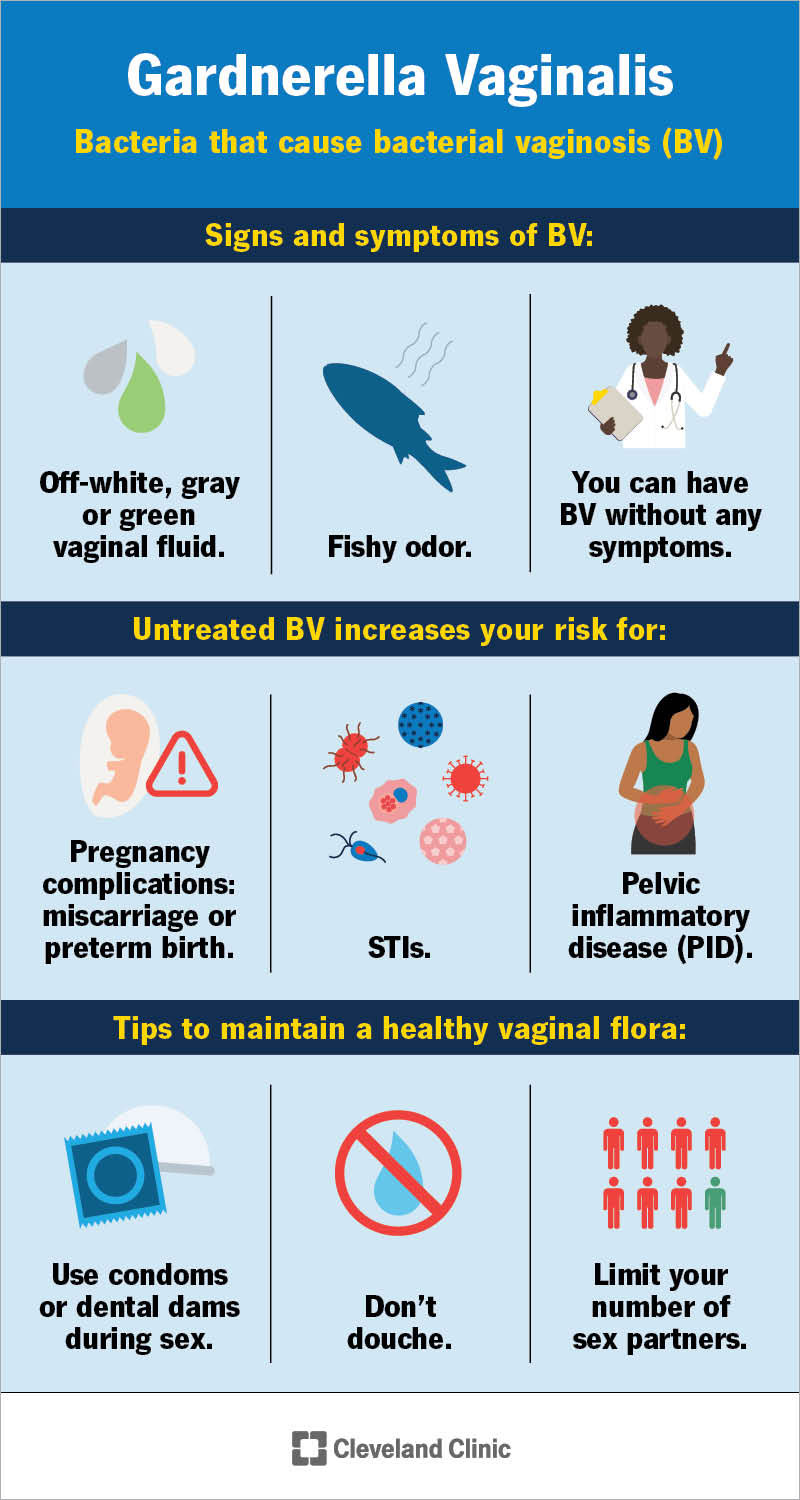Gardnerella vaginalis is a bacterium that lives alongside other bacteria in your vagina to keep it infection-free. When too many Gardnerella bacteria grow, you can develop an infection called bacterial vaginosis (BV). BV is a very common infection that your provider can treat with antibiotics.
Advertisement
Cleveland Clinic is a non-profit academic medical center. Advertising on our site helps support our mission. We do not endorse non-Cleveland Clinic products or services. Policy

Gardnerella vaginalis (or G. vaginalis) is a type of bacteria inside your vagina. It’s part of what’s known as your microbiome or vaginal flora. Your vaginal flora contains many kinds of bacteria (and in different amounts) to keep your vagina healthy. The bacteria coexist in a delicate balance.
Advertisement
Cleveland Clinic is a non-profit academic medical center. Advertising on our site helps support our mission. We do not endorse non-Cleveland Clinic products or services. Policy
When your levels of G. vaginalis and other BV-associated bacteria are in balance with the other good bacteria, your vaginal flora prevents you from getting infections. If there’s an imbalance and too much grows, you can get a vaginal infection called bacterial vaginosis (BV). BV isn’t a sexually transmitted infection (STI).
The purpose of bacteria in your vagina is to keep it healthy. When you have the right amounts of these bacteria, your vaginal flora is in balance and infection-free. But if this balance is thrown off, bacteria can overgrow and cause an infection like BV.
When scientists first discovered G. vaginalis in 1955, they thought it was a bad bacteria that caused vaginal infections. Research now shows that things aren’t so straightforward. People with vaginal infections have Gardnerella in their vaginas, but people without vaginal infections also have Gardnerella in their vaginas. This means that Gardnerella alone isn’t to blame for vaginal infections. Instead, it mainly depends on its balance with other bacteria like Lactobacillus. There are also several other types of bacteria that live in your vagina in smaller amounts.
We also know that Gardnerella plays a role in maintaining a healthy pH, or a healthy amount of acidity, in your vaginal fluid. A healthy vagina has a pH range of 3.8 to 4.5. The bacteria that make up your vaginal flora work to maintain this level of acidity, which is just the right amount for fighting infection. When the acidity levels drop, too much Gardnerella grows, and that’s when an infection can occur.
Advertisement
Gardnerella lives inside your vagina, as one of many microorganisms that are part of your vaginal flora.
Gardnerella isn’t something that you can catch. Instead, G. vaginalis is a natural part of the environment in your vagina. You can get bacterial vaginosis (BV) if too much grows.
If too much Gardnerella begins to grow, you may start to notice changes in your vaginal discharge that are signs of BV. The fluid from your vagina may:
You can have BV without having any symptoms at all.
No, but they’re related. Having too much Gardnerella in your vaginal fluid is a sign that you may have BV. You get BV when the balance of bacteria that keeps your vaginal flora healthy becomes disturbed. Most often, it’s when two different kinds of bacteria in your vagina are off balance.
People with BV have too little lactobacilli bacteria in their vaginas and too much Gardnerella bacteria. Lactobacilli bacteria help keep your vagina acidic. Not having enough lactobacilli bacteria causes your vaginal pH to increase to 4.6 or more, so that your vagina isn’t acidic enough.
In this environment, Gardnerella start to multiply, and other bacteria begin to cling to the Gardnerella bacteria and grow, too. When this happens, you get BV. But Gardnerella alone doesn’t cause BV. An imbalance in your vaginal flora causes BV.
No. Gardnerella isn’t a sexually transmitted infection (STI). In fact, sexual activity alone doesn’t seem to cause overgrowths of Gardnerella bacteria or BV. People who aren’t sexually active can have too much Gardnerella bacteria and get BV.
Remember, having G. vaginalis in your vagina doesn’t mean you have an infection. Healthy vaginas have Gardnerella bacteria in them. This isn’t the case with other common STIs, where the presence of the bacteria means that you have an infection.
Just because Gardnerella isn’t an STI-causing bacteria doesn’t mean that sexual activity isn’t a risk factor when it comes to getting BV. It is. The causes of BV are unknown, but you’re more likely to get an infection if you have multiple sexual partners or if you have a new sex partner.
Your provider can look at your vaginal fluid under a microscope to check for cells that may indicate G. vaginalis is present.
If you have unhealthy amounts of G. vaginalis, you could get BV. Untreated BV increases your risk for:
Your provider may prescribe oral (a pill you swallow) or intravaginal (you place it inside your vagina) antibiotics to return your Gardnerella to healthy levels and treat BV.
Advertisement
Anyone with a vagina will have Gardnerella in their vagina. Testing positive for it doesn’t mean you have an infection. It only becomes a problem when you have an unhealthy or unbalanced amount in your vagina.
No. Healthcare researchers are still studying if there’s a definitive connection between HPV (human papillomavirus) infection and Gardnerella.
Don’t be alarmed if you learn that you have irregular levels of Gardnerella vaginalis bacteria. It’s a common type of bacteria that your vagina is supposed to have in it. If your provider tells you that you have an overgrowth of Gardnerella or that you have bacterial vaginosis, rest assured that the condition is treatable. A course of antibiotics can get your vaginal flora back to healthy levels within about a week.
Advertisement
From routine pelvic exams to high-risk pregnancies, Cleveland Clinic’s Ob/Gyns are here for you at any point in life.

Last reviewed on 07/03/2024.
Learn more about the Health Library and our editorial process.